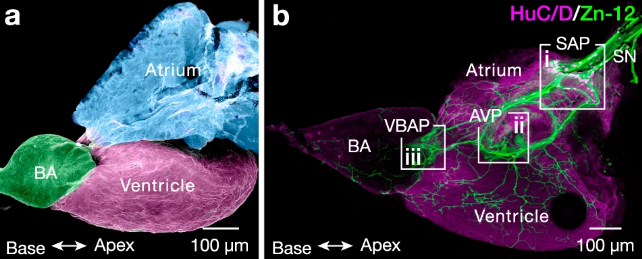Long before we’re born, our heart’s tissues twitch and convulse in a rhythm that only ceases in our final hour.
It’s a function so mechanical we could be forgiven for overlooking its complexity. Yet every contraction is as considered as a musician’s note, played with gusto or gentleness under the direction of an architecture of nerves buried just beneath the outer layers of the heart.
Known as the intracardiac nervous system, these pathways were assumed to be a mere stopping point for information transmitted by parts of the brain and spinal cord.
Scientists from the Karolinska Institutet in Sweden and Columbia University in the US have now uncovered a startling level of complexity among the neurons encasing the zebrafish’s heart, challenging existing theories on how the organ’s pulse is maintained in animals like ourselves.
“This ‘little brain’ has a key role in maintaining and controlling the heartbeat, similar to how the brain regulates rhythmic functions such as locomotion and breathing,” says Karolinska Institutet neuroscientist Konstantinos Ampatzis, who led the study.
For much of history it’s been thought the heart’s activity was self-governed, thumping out its own steady beat under its own animus that many cultures contended was the very essence of life itself.
The heart’s independence was given a new perspective by the 18th-century German anatomist Albrecht von Haller, who in his summary text on physiology claimed the heart has an “intrinsic irritability” triggered by the blood that enters it.
In the 19th century, bundles of nerves called ganglia were found in frog hearts, then in those of humans, which were quickly understood to perform the role of a cardiac ‘pacemaker’, controlling the rate of muscular contractions.
It would be the beginning of centuries of investigation into the heart’s steadfast ability to keep beat, with scientists debating the extent to which the central nervous system governed the pulse.
Today, the brain is thought to hold sway over cardiac function through its two branches – the ‘fight or flight’ sympathetic system and the ‘rest and digest’ parasympathetic system.
It manages this through multiple neural pathways that link the heart’s twitchy muscle fibres with peripheral ganglia, which are in turn connected to bundles of neurons in the central nervous system, tweaking the beat from afar in response to chemical and pressure stimuli.
Given the scrutiny of generations of scientists, it’s not only surprising that the argument over the brain’s influence continues, but that there is so much still to be discovered about the heart’s structure.
Ampatzis and his team used a combination of immunological labeling, RNA profiling of individual cells, and an analysis of the electrical properties of neurons weaving through the heart tissue to develop a detailed map of the intracardiac nervous system of a zebrafish heart.
The researchers uncovered a high diversity of cell types, including a subset of nerves that resembled central pattern generator neurons in the central nervous system, pathways that govern everything from chewing food to walking to ejaculating.

In spite of being separated by hundreds of millions of years of evolution, humans and zebrafish have surprisingly similar cardiovascular physiology, implying that most vertebrates share these nervous pathways.
Taken into consideration with existing knowledge, it appears likely that vertebrate hearts have a more sophisticated ‘brain’ than anybody realized, consisting of a pacemaker that kicks the heart into action and a regulatory middle manager that takes cues from the central nervous system before deciding how the heart should respond.
“We were surprised to see how complex the nervous system within the heart is,” says Ampatzis. “Understanding this system better could lead to new insights into heart diseases and help develop new treatments for diseases such as arrhythmias.”
Far from drawing a clear line between the heart and the brain, the findings pose new questions on how those cues vary with disease, diet, and activity, with future studies potentially revealing novel targets for treatments that can keep the ol’ ticker tapping for years to come.
This research was published in Nature Communications.








Leave a Comment